by Philbert Ono
Updated: Jan. 26, 2021
Part of an article series on Yaeyama folklore in scenic Okinawa, Japan.
(八重山名勝の民話・民謡の英語訳シリーズ記事)
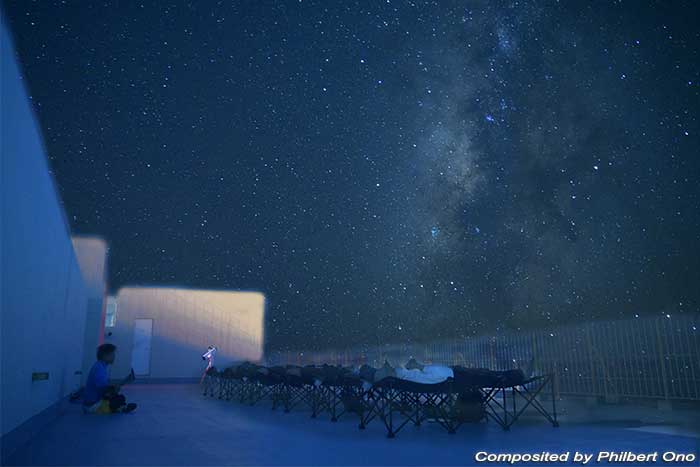
On a recent trip to Japan’s most remote islands, the Yaeyama Islands in southwestern Okinawa Prefecture, I got starstruck and moonstruck by the night sky. While gazing at the twinkling stars above Ishigaki, we enjoyed our tour guide singing Okinawan stargazing folk songs such as “Tinsagu nu Hana” with his sanshin (photo above).
He sang verses like:
In the heavens, stars in the Pleiades cluster are countable if you try. But the teachings of your parents are not.
I soon realized how the stars and moon had a close cultural connection in the islands. Upon further reading, it turns out Yaeyama has had a long history and rich folk culture of stargazing and moon viewing. Even today, there’s much local and tourist interest in stargazing in Yaeyama, dubbed as Japan’s best place for stargazing.
Welcome to this comprehensive beginner’s guide to stargazing in the Yaeyama Islands, Okinawa Prefecture, Japan.
⭐ Contents ⭐
- About Yaeyama and Getting There
- Why stargazing in Yaeyama?
- Yaeyama Stars and Constellations
- Yaeyama Stargazing Weather
- Pleiades Star Cluster
- Okinawa/Yaeyama Stargazing Folk Songs
- “Murikabushi Yunta” (Pleiades Star Cluster Work Song)
- “Tinsagu nu Hana” (Balsam Flowers) – Separate page
- “Tsuki nu Kaisha” (Beautiful, Beloved Moon) – Separate page
- Yaeyama Stargazing Tours
- Ishigaki Stargazing Attractions
- Japanese Stargazing Vocabulary
About Yaeyama and Getting There ✈️
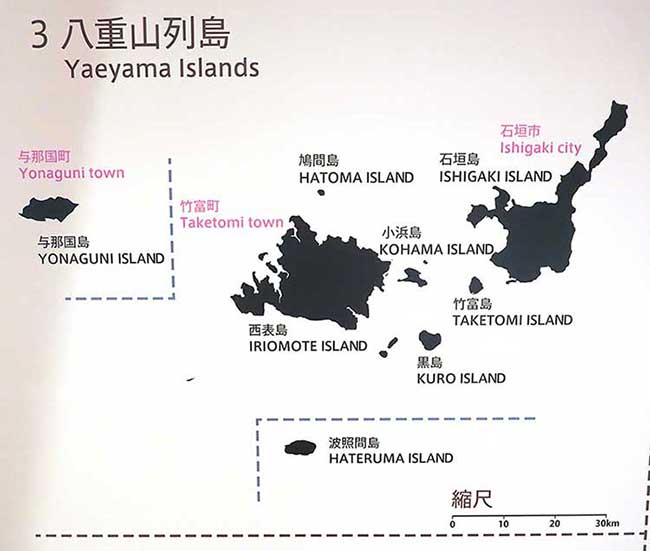
The Yaeyama Islands (八重山諸島) in southwestern Okinawa Prefecture is a cluster of 20+ large and small subtropical islands centering on Ishigaki (石垣) and Iriomote (西表) islands. They are the most remote islands from the Japanese mainland, even farther away than the Ogasawara Islands south of Tokyo.
However, they are easy to reach with direct jet flights from Tokyo, Kansai, Nagoya (Chubu), Fukuoka (seasonal), and Naha (on Okinawa’s main island) to Ishigaki Airport on Ishigaki Island, the main gateway to Yaeyama.
Besides direct flights to Ishigaki, you can also first fly to Naha Airport, then fly to Ishigaki. From Tokyo’s Haneda Airport, it’s about a three-hour flight to Naha Airport, then a one-hour flight from Naha to Ishigaki Airport.

Eleven of the Yaeyama Islands are inhabited and the total population is about 54,000 with about 49,600 living on Ishigaki, the main Yaeyama island. Ishigaki’s southern coast has Ishigaki Port where boats take you to the other Yaeyama Islands. Ishigaki to Iriomote takes about 40 min. by boat. If you know Hawaii, both Ishigaki (222 km2) and Iriomote (289 km2) are still much smaller than Lanai (364 km2). The Yaeyama Islands are usually just referred to as “Yaeyama” without any island named “Yaeyama.”
Although most of us think of Okinawa as one small prefecture, Okinawa actually covers a wide geographical area (mostly ocean). Okinawa’s main island and Yaeyama are 400 km apart, same as between Tokyo and Osaka. The main island and Yaeyama have therefore developed a very different language/dialect and culture. The different islands all have different dialects and culture.
Why stargazing in Yaeyama?
🌟 Excellent location for stellar views: Okinawa’s main island is 1,000 km south of the Japanese mainland (three-hour flight from Tokyo), and Yaeyama is further south by 400 km (one-hour flight from Naha). This translates into Yaeyama being over 10 degrees latitude south of Tokyo, putting it just above the Tropic of Cancer. (Almost the same as Hawaii slightly below the Tropic of Cancer.) This location at the 24th parallel north enables Yaeyama stargazers to see stars and constellations in the southern sky that cannot be seen from the Japanese mainland. Also, there is minimal jet stream turbulence directly above, making the atmosphere look clearer. It’s like looking at a crystal-clear river through still waters instead of a gushing stream. Of course, if you live in Australia or New Zealand, this location might not sound so impressive. But I’m talking within the framework of Japan…
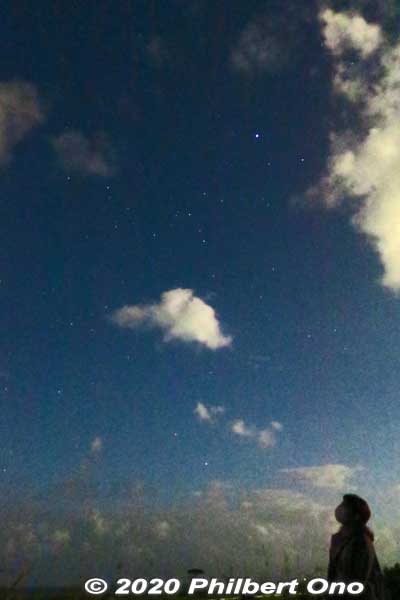
🌟 More visible stars and constellations: Thanks to its southern location, Yaeyama can see more constellations (84) and first-magnitude stars (all 21) than anywhere else in Japan. Many of the constellations and stars (including the Milky Way) appear higher in the sky, making them easier to see. (See Yaeyama All Stars below.)
🌟 Minimal light pollution: Even the most populous Yaeyama island of Ishigaki remains largely rural with many dark sites for stargazing. You don’t need to go far to escape street lights and view the night sky. Conscious efforts are also being made to minimize light pollution in populated areas and to promote the appreciation of the stars.
🌟 Strong local interest and folk culture: There are stargazing facilities (including large telescopes), stargazing tours, volunteer stargazing sessions, and a large stargazing summer festival. (See Yaeyama Stargazing Tours and Yaeyama Stargazing Attractions below.)
In 2006, the starry-eyed island of Ishigaki even promulgated its Ishigaki Island Stargazing Declaration (いしがき島星空宣言), promising to give attention and importance to its starry skies, pass on its stargazing culture, and preserve its natural environment for future generations.
The stars and moon have also long been part of local folklore, appearing in folk tales and folk songs. (See Stargazing Folk Songs below.)
🌟 International recognition: In 2018, Yaeyama’s stargazing efforts received international recognition when Iriomote-Ishigaki National Park was designated as Japan’s first International Dark Sky Park by the US-based International Dark-Sky Association. (In Nov. 2020, Kozushima Island in Tokyo was designated as Japan’s second International Dark Sky Park.)
✨ Yaeyama All Stars ✨

Yaeyama’s standard stargazing PR blurb is, “You can see 84 of the 88 constellations, more than anywhere else in Japan.* Also see all 21 first-magnitude stars, the brightest stars in the night sky.” (Only 16 are visible from the Japanese mainland of Honshu.) And throw in “all four stars of the Southern Cross (Crux) are also visible in Yaeyama and nowhere else in Japan.”
*Some of the 84 visible constellations are only partially visible. The four constellations not visible at all are Chamaeleon, Mensa, Octans, and Apus.
All this sounds terrific, but unless you live in Yaeyama for at least a year, you won’t be able to see all these constellations and stars on any single trip to Yaeyama.
The stars you can actually see in Yaeyama will depend on the month, weather, and lunar phase. The constellations and stars appearing in the night sky will differ each season. The Milky Way (Tingara in Okinawan) flows from south to north from July to October. Yaeyama’s southern latitude makes the Milky Way look wider and higher in the sky, especially in summer.
In winter, the Orion constellation and many first-magnitude stars can be seen. The four stars of the Southern Cross are visible from late December to mid-June (live camera image from Ishigaki).
The much beloved Pleiades (aka Seven Sisters), the brightest star cluster in the night sky, is most visible from October to mid-March (more about the Pleiades below). The Pleiades is part of Taurus.
By mid-January, all 21 first-magnitude stars appear in the same sky. Canopus (Star of Longevity), the second-brightest star after Sirius, is visible from mid-January to mid-March. See it and live long, according to legend. If it’s a clear sky and you’re willing to stay up all night until 5 or 6 am, it’s possible to see all 21 first-magnitude stars during the same night in mid-January. It’s a rare thing to do since it rains often in January.
However, on Jan. 15, 2021, a lucky group from the Ishigaki Nature House for Youth (石垣青少年自然の家) on Ishigaki did it. The starry activity was called “First-Magnitude Star Marathon” (一等星マラソン). By 10 pm, they spotted 11 first-magnitude stars. While taking breaks or a nap, they sighted the rest by 6 am the next morning to complete the marathon in the sky.
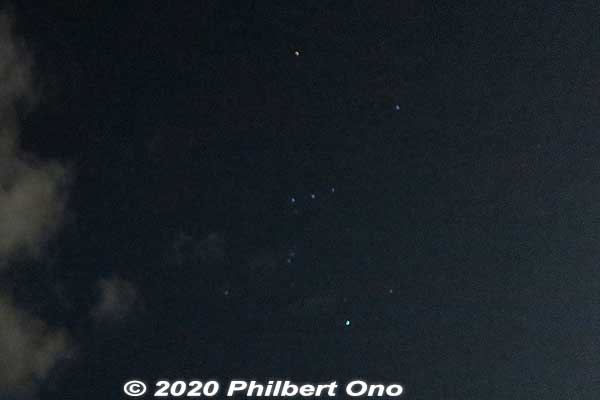
✨ Yaeyama Constellations ✨
Here are some major constellations and stars appearing above Yaeyama according to season:
Spring (March–May): Big Dipper, Ursa Major, Arcturus, Spica, Leo, Hydra, Corvus, Virgo, Southern Cross, Pleiades
Summer (June–August): Milky Way, Vega, Altair, Deneb, Cygnus (Swan), Scorpius, Antares, Sagittarius, Ophiuchus, Libra
Autumn (September–November): Cassiopeia, Pegasus, Formalhaut, Pisces, Piscis Austrinus, Aquarius, Cetus, Capricornus, Andromeda, Perseus, Perseids meteor shower (mid-August), Pleiades
Winter (December–February): Orion, Betelgeuse, Rigel, Sirius, Canis Major, Procyon, Aldebaran, Taurus, Gemini, Castor, Pollux, Capella B, Auriga, Canopus, Southern Cross, Pleiades
Whichever month you decide to go (hopefully not during a full moon), there will be something to see in the night sky. If you make reservations for a stargazing tour (see Yaeyama Stargazing Tours below), they can tell you what you can expect to see.
🌤️ Yaeyama Stargazing Weather
Needless to say, stargazing is at the mercy of the weather. March to October is considered to be the best time for stargazing in Yaeyama, especially July and August when it rains least often (when there’s no typhoon). The air in summer is also clear and not hazy like on mainland Japan.
Rain is possible on any day of the year, but there are months when rain is more frequent. Yaeyama’s wettest months are December to January and mid-May to late June (rainy season). Typhoon season is from late July to early October. On average, one or two typhoons can hit Okinawa per month in summer. A typhoon would last no more than one or two days. If you visit in a rainy month, best to allow a more flexible (longer) schedule.
Cloud conditions can also change quickly. A clear sky can later see clouds, or a cloudy sky can become clear or fair. A full moon will also make the stars less visible, but moon viewing is enjoyable as well.
Yaeyama’s subtropical climate is a lot warmer than the Japanese mainland. In winter, the temperature normally doesn’t go below 15˚C (59˚F). Summer temperatures start from late March when beaches open for swimming. Late April is already summer. Short-sleeve weather in Okinawa can continue until early November.
Pleiades Star Cluster (プレアデス星団)
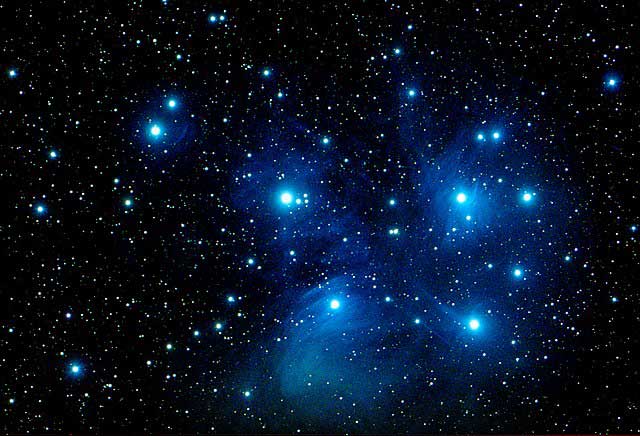
In Yaeyama, the Pleiades star cluster (aka Seven Sisters) has occupied a special place not only in the night sky, but also in people’s hearts. It’s the star cluster (not constellation) most visible to the naked eye at night. A small, but bright, distinctive group of six or seven stars in the Taurus constellation. It’s one of the closest star clusters to Earth.
Being relatively young stars (only 100 million years old compared to our Sun over 4 billion years old), they have a bluish tinge and dust clouds illuminated by the stars. The dust clouds are not visible to the human eye, but may appear in long-exposure photos.
Above Yaeyama, it rises from the east to the top of the sky, then descends west. It’s visible in the Yaeyama sky most of the year except in May and June. They were especially important and beloved by Yaeyama farmers centuries ago when they tracked the position of the Pleiades to set their farming schedule.
The Pleiades do look like a cute bunch of close sisters or friends in the sky. When I first saw them with binoculars on Ishigaki, I could hardly take my eyes off of them. They sure have lots of star power. The Pleiades are nicknamed Subaru (昴) in Japanese (pronounced “Su-BAH-roo,” not “Su-boo-roo”), originating from the word meaning “come together as one” (統る). The Japanese car maker and the Subaru Japanese telescope on Mauna Kea in Hawaii are both named after it. Beloved even on mainland Japan and around the world.
In Yaeyama, due to the many different dialects on the different islands and in different villages, there are many different names for the Pleiades cluster. They include Murikabushi (むりかぶし), Muribushi (群星), Murebushi, Munibushi, and Nnibushi (んにぶし). They all basically mean “group of stars.” In Tonoshiro, Ishigaki, it’s called Kuna-busu (クナー星) meaning “stars who are close friends.”
The famous Okinawan folk song “Tinsagu nu Hana” mentions Muribushi in Verse 2. The telescope at the Ishigakijima Astronomical Observatory is nicknamed Murikabushi which is what the cluster is commonly called in Ishigaki. The Pleiades was synonymous with what we now call “star cluster” (seidan 星団). I’ll call it “Murikabushi.”
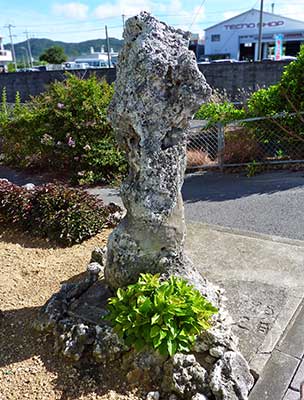
💫 Calendar Written in the Stars
When Yaeyama farmers didn’t have or use a calendar, they used Murikabushi’s position in the sky and other starry positions to decide when to start planting or harvesting their crops before the typhoon season. The timing for planting was especially critical for rice (late January to early February) since it affected how big the harvest would be. In the old days, they didn’t have greenhouses to cultivate seedlings, so they planted the rice seeds directly into the paddy.
By coincidence, Murikabushi disappeared from the sky during Yaeyama’s rainy season from early May to late June. That’s how they knew it was the rainy season. Villagers would refer to the rainy season as “Murikabushi’s vacation.” Murikabushi in effect served as the farmer’s calendar.
As early as the 17th century, Yaeyama farmers even used stargazing rocks (星見石 bushimi-ishi) as a reference point to check the alignment or position of Murikabushi at the specific time. The rocks were either standing rocks (photo) or flat, dial-like rocks with grooved directional markings. All the Yaeyama islands and villages had these rocks.
A few of these stargazing rocks still stand in Yaeyama today. Most have been moved to a different location due to land development. This has made it difficult for today’s researchers to see how the rocks were actually used. Farmers also checked the position of stars compared to the mountains on the horizon.
To the farmers, Murikabushi really were lucky stars to thank since it brought them bigger harvests with the correct timing for planting their crops (mainly rice). Since people had to pay heavy taxes in rice imposed by the Satsuma Domain and Ryukyu Kingdom, maximizing their harvests was essential. The farmers were truly grateful to the stars.
Murikabushi Yunta (むりかぶしユンタ)
The Pleiades star cluster has thus had a close historical and cultural association with agriculture in Yaeyama. The Pleiades have also inspired folk tales, legends, folk songs, and festivals in Yaeyama, Okinawa, Japan. One Yaeyama folk song is even called “Murikabushi Yunta” (Pleiades Star Cluster Work Song). Yunta is a genre of Yaeyama min’yo folk songs. They were work songs sung like a duet by male and female farmers working in the field (no musical instruments). The song tells the following tale:
Murikabushi Yunta (むりかぶしユンタ 英語訳))
Once upon a time, farmers on the Yaeyama Islands suffered from heavy taxation from the government. Thieves and pirates also robbed people. Life in Yaeyama was rough and tough.
Seeing this turmoil, the King of the Heavens ordered the Seven Stars of the South to eliminate the suffering and make life in Yaeyama good again. However, the Seven Stars of the South replied, “No, we’re unable to do such a thing.” This so enraged the King that he banished the Seven Stars of the South to a small corner of the southern sky and had them do the maki-odori circle prayer dance.
The King then ordered the Seven Stars of the North to make things right in Yaeyama again. However, the Seven Stars of the North also replied, “No, we’re unable to do such a thing.” This so enraged the King that he pushed the Seven Stars of the North to a small corner of the northern sky and had them dance the kumi-odori court dance.
All the stars were deathly afraid of the King of the Heavens and could not utter a word or even approach him. That’s when a small bunch of stars named Murikabushi came before the King and asked, “Your Majesty, please let us do the job.” The surprised King said, “You puny stars think that you can bring peace and calm to Yaeyama??” The little stars declared in a loud voice, “YES, WE CAN!!”
The King was delighted and proclaimed, “I shall put you in the middle of the sky, so you can always see all of Yaeyama and all of Yaeyama can always see you.”
From then on, Murikabushi rose from the ocean in the east, reached the middle of the sky, then descended into the ocean in the west. Yaeyama farmers observed Murikabushi and used stargazing rocks to know when the seasons passed and when to plant their crops. Thanks to Murikabushi, their harvests became abundant enough for them to pay their taxes and live well. Murikabushi was their heavenly guide and savior.
Translated into English by Philbert Ono.
It’s not known for certain which were the Seven Stars of the South. One theory says that it could be the six bright stars (南斗六星) in the upper body of Sagittarius. The Seven Stars of the North is said to be the seven Big Dipper stars.
After working in the fields, farmers would sing “Murikabushi Yunta” while walking home to express their happiness in how Murikabushi made their village prosperous. Verse 1 of the song is translated below. (Sung by Kinjo Hiromi in the video.) There are actually many more verses.
For the International Year of Astronomy in 2009, “Murikabushi Yunta” was included in the Stars of Asia Project to collect and publish Asian myths and legends related to the stars and universe (「アジアの星の神話・伝説」プロジェクト). The project amassed quite a collection of stories from all Asian countries and an English version of the resulting book (Stars of Asia Common Book) was published. However, the book no longer seems to be available. 😢
Murikabushi Yunta, Verse 1
ムリカ星、星ドゥヨウ
天ヌアージィ マイカラ
島ウタイデユチャラ国ウタイデユチャラ
ウーフデウキダウユヤンドゥ
島ヌ真上カラ天ヌ真中カラ
物作リィシ ウラバ
ムリカ星 見当ティシThe Murikabushi (Murikabusu) stars were
ordered by the King of the Heavens
to placate and supervise the Yaeyama Islands.Ordered to placate Yaeyama,
the Murikabushi stars said “Yes.”
They move and work directly above Yaeyama.They move through the middle of the heavens.
Translated into English by Philbert Ono.
Therefore, when farming, be sure to
look to Murikabushi as a guide.
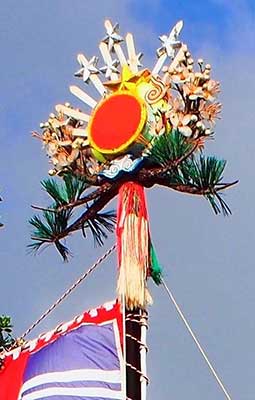
Pleiades Utaki and Harvest Festival 🙏
Okinawa has many sacred sites of worship called utaki (御嶽) where a god may dwell, based on local religious beliefs. The utaki usually has a torii (although it’s not Shinto) and no fancy buildings. They typically occupy a small plot of land with an enclosing wall and small hut. There’s usually a woman priestess (神司) who conducts religious ceremonies. Regular people (especially men) are prohibited from entering the inner sanctum of the utaki. We can only view the torii and outer wall of the utaki.
In Kabira, Ishigaki, there are four utaki (called “on” in Yaeyama dialect), and one of them is Nnibushi-on (群星御嶽、ンニブシオン) dedicated to the Pleiades star cluster. In the Kabira dialect, the Pleiades are called Nnibushi (pronounced “Un-ni-bushi“).
The heavily wooded Nnibushi-on sacred site is especially important in Kabira since it is related to the founding of Kabira Village. (See the Nnibushi-on folk legend below.)
Utaki sites are also used to hold local religious ceremonies and festivals. In July and August, the Harvest Festival (豊年祭、プーリィ) (Puuri in Ishigaki dialect) is held in numerous places in the Yaeyama Islands to give thanks for a rich harvest, to pray for a rich harvest in the following year, and to pray for everyone’s good health.
The lively festivals feature singing, dancing, drumming, tug of war, and the parading and jostling of tall banner poles called hatagashira (旗頭). The hatagashira serve as the village or neighborhood’s symbol and divine protector. The hatagashira poles have a large ornament (灯篭) on the tip and a red banner written with harvest-related prayer words.
The Nnibushi-on utaki also holds the Harvest Festival (video here) and its hatagashira pole ornament has six Nnibushi Pleiades stars above a red sun and Ryukyu pine tree branches on the bottom (photo).
People also sing “Murikabushi Yunta.” The festivals bring the community together and pass on local songs and dances to the next generation. (In 2020, sadly the festivals were canceled due to fears of coronavirus.)
Here’s the folk legend behind the founding of the Nnibushi-on sacred site:
Nnibushi-on Origin (群星御嶽 伝承の英語訳)
Once upon a time in Kabira Village on Ishigaki, there was a well-mannered, warmhearted girl in the Haeno family. One night, she awoke and went outside. When Nnibushi reached the top of the sky, she saw a long, slender tube connecting Nnibushi with the ground. There was a flame going up and down the tube between Nnibushi and the ground. She couldn’t believe her eyes at first, but she saw the same thing every night whenever Nnibushi was at the top of the sky.She told her family and the village elders about it. Everyone was really surprised to hear it. So one night, they all gathered to see it together. Sure enough, they saw a flame going up and down the tube. They thought it must be the God of the Heavens coming down to Earth. So they all went to where the flame reached the ground. At that spot, they saw a round marking outlined with white rice powder.
The villagers then designated that spot as sacred and built an utaki site for it. It became the village’s central place for worship and was called “Nnibushi-on.”
At the same time, the Haeno girl refused to eat any cooked food. She only consumed a raw soup made with uncooked rice soaked in water and ground in a bowl.
Everyone saw this as a sign that she was the God’s servant. From then on, the priestess (神司) of the Nnibushi-on in Kabira came from the Haeno family (南風野家).
Translated into English by Philbert Ono.
Okinawa/Yaeyama Stargazing Folk Songs (沖縄・八重山の星空・月見の民謡)
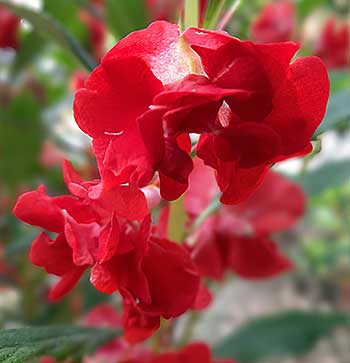
Yaeyama’s prime conditions for stargazing and moon viewing also inspired many local min’yo folk songs. Two of the most famous songs mentioning the stars or moon are “Tinsagu nu Hana” (てぃんさぐぬ花) and “Tsuki nu Kaisha” (月ぬ美しゃ) which our tour guide also sang for us as we gazed at the stars. I’ve written separate blog posts explaining each song with lyrics translated into English. Click on the song title or “Read more” links below.
⭐ “Tinsagu nu Hana” means “Balsam Flowers” in the Okinawan language. The infectious, emotional melody and meaningful lyrics have made it one of the most famous and endearing songs in Okinawa for generations. Rather than the flowers, the song is mainly about filial piety, teaching children how much they owe their parents (and grandparents) and how they must respect and listen to their elders.
Stars are mentioned in Verses 2 and 3. Verse 2 mentions Muribushi (群り星), the Pleiades star cluster. Muribushi is commonly translated as all the stars in the sky or Milky Way. In Verse 3, the North Star is mentioned as a guide for ships. Read more here…
🌔 “Tsuki nu Kaisha” can be translated as “Beautiful, Beloved Moon.” It’s perhaps the most famous Yaeyama moon-viewing or tsukimi song. “Tsuki” means “moon,” and “Kaisha” (美しゃ) in the Yaeyama dialect means “beautiful” as well as “beloved” and “close to the heart.” A common word in Yaeyama. The first three verses celebrate the autumn moon.
The song’s first and most famous line is, “The moon is most beautiful on the 13th night” instead of the full moon on the 15th night. Most people think the full moon is most beautiful, but not this song. The time before the peak is most beautiful, it says. The meaning is subject to interpretation, but perhaps it’s like the journey being more enjoyable than the destination itself. The song was originally sung by babysitters as a bedtime lullaby in Yaeyama. Read more here…
🔭 Yaeyama Stargazing Tours (八重山の星空ツアー)
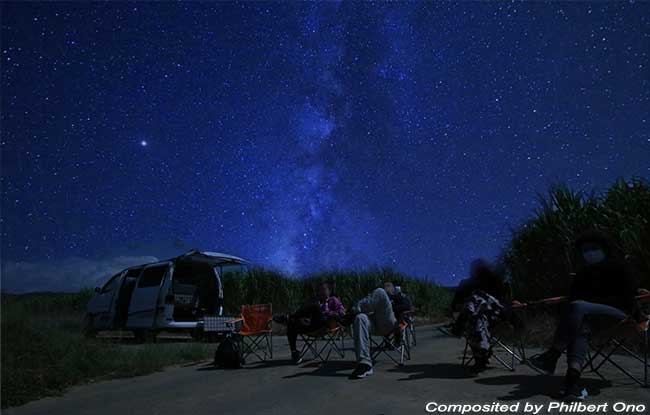
Stargazing tours in Yaeyama are quite well developed for Japanese tourists. But not yet for foreign tourists. Although they welcome tourists of any nationality, foreign language support is still lacking in stargazing tours and Yaeyama tourism in general. (That’s why I’m writing this article.)
If there’s a hotel or inn on the Yaeyama island, you can be sure there’s a stargazing tour. Ishigaki is the most populous island with the most hotels, and so it has the most stargazing tours. Iriomote, Taketomi, Kohama, and Kuroshima islands also have lodging and stargazing tours. Your hotel/inn can put you in touch with stargazing tour operators.
Although you can go stargazing on your own, I recommend going with a local stargazing guide. The guide can take you to a prime viewing site and point out the stars and constellations.
The stargazing can either be held on your hotel’s property or they may drive you to a dark, rural spot where you sit on reclining camping chairs. The stargazing guide will use a laser pointer to point out the stars. Binoculars or a telescope might be provided. Guided stargazing outings usually last for an hour or two and cost a few thousand yen. However, be prepared for the “In Japanese only” caveat.
Stargazing tours are language-heavy with the guide pointing out the stars and constellations in Japanese. There’s a lot of Japanese stargazing terminology. (See Stargazing Vocabulary at the end of this article.) There’s no time to interpret what they say into English unless you have your own simultaneous interpreter.
If you don’t understand Japanese, I recommend the smaller stargazing tours for small groups. It will be more personalized and they will have the time and motivation to try and communicate with you. Guides for large stargazing groups (including stargazing cruises) won’t really have the time for any English explanations or questions.
Unless you’re a stargazing expert, I recommend asking your stargazing guide in advance what you will be seeing in the sky. Then read up on the major stars (hoshi 星), constellations (seiza 星座), and star clusters (seidan 星団) you might be seeing. It will make it easier to recognize them and understand what’s going on during the stargazing. (I didn’t do this, so a non-expert like me was almost completely lost while stargazing in Yaeyama. I speak Japanese, but my astronomy vocabulary even in English was very limited.)
If you also want to take pictures of the stars, I recommend doing some reading on astrophotography too. Minimum required equipment would be a D-SLR (manual controls), wide-angle lens, and sturdy tripod for long exposures.
If the stargazing tour has to be canceled due to the weather, you should be able to receive a refund or be able to change your reservations for another night.
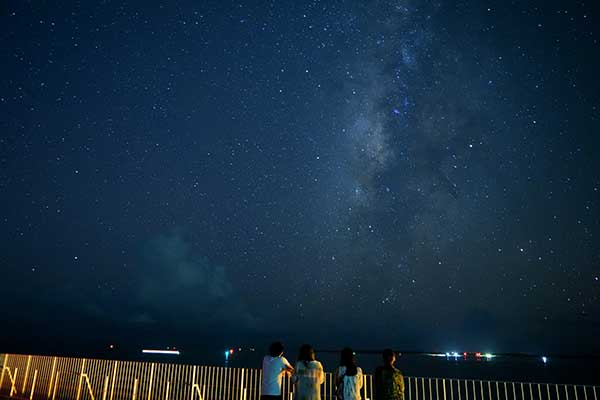
⭐ Ishigaki Stargazing
On Ishigaki, we experienced two stargazing outings in early November during a full moon. One was called Shani-shani Stargazing Tour (しゃにしゃに星空ツアー) on the rooftop of Ishigakijima Beach Hotel Sunshine. Shani-shani means “to make your heart flutter or excited” in the local Yaeyama dialect. It was geared for small groups, no more than 15 people, so it was easy for us to ask questions and get more personal attention.
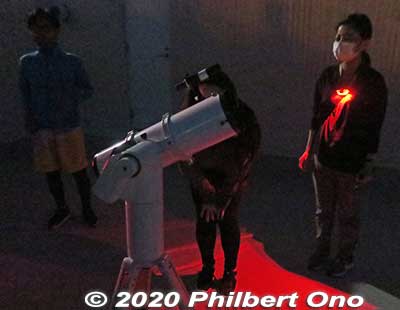
On the rooftop (topmost photo), we lied down flat on cots and gazed upward while our stargazing guide Keiko-san from Utakuna Ishigakijima used a laser pointer to point out stars and constellations. Our tour guide Hiroshi-san also sang stargazing songs as a special treat only for us. (Normally, there’s no live singing during the stargazing session.)
Keiko-san also had a telescope through which we saw Saturn (including the white ring) and the full moon. In Japan, the moon looks like there’s a rabbit pounding mochi in a mortar. It could also be a grandma sitting and reading a book. An interesting and relaxing time.
The stargazing session is 45 min. long and available four nights a week at the hotel. Anyone can join this event, but those staying at Ishigakijima Beach Hotel Sunshine receive a slight discount. The hotel was also designed to minimize light pollution by using subdued lighting and lights pointing downward.
Our other Ishigaki stargazing experience was conducted by Ishigaki Hoshizora Farm (石垣島星空ファーム) in the middle of a dark, sugar cane field in an area called Miyara (宮良), about 20-min. by car (or taxi) from central Ishigaki. Sugar cane fields are ideal because they have no streetlights. We were in a grassy clearing in a cane field sitting on reclining camping chairs. (The place is private property and not open to the public.)
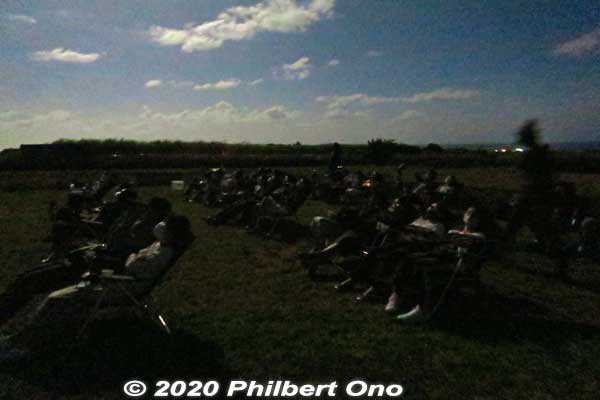
We were with a large group of people. For one hour from 9 pm to 10 pm, our stargazing guide used a laser pointer to point out stars, constellations, and planets almost nonstop in Japanese. No English of course, and no time for questions. Binoculars were also provided for each person. They came in handy to see the Pleiades star cluster and the beautiful full moon. A shooting star also brought cheers.
If you have a car on Ishigaki and want to stargaze on your own, there’s Tadahama Beach (多田浜海岸), hilltop Banna Park Minaminoshima Lookout (バンナ公園・南の島の展望台), and Maesedake Lookout (前勢岳展望台) all close to central Ishigaki. Slightly further away is the Nagura Bay area (名蔵湾). Avoid the eastern part of Ishigaki due to the lights and airplanes from the airport. Drive carefully on Ishigaki (and anywhere in Okinawa) because the roads can be dark and narrow.
⭐ Iriomote Stargazing
Iriomote Island is much less populated and more rural than Ishigaki. So lots of dark sites for stargazing. Local tour company motti takes small groups to stargazing spots on the island, mainly in the middle of cow pastures or sugar cane fields well away from streetlights. If you’re staying in the Ohara or Otomi area, they can pick you up at your hotel. Note that for safety reasons (explanation to ensure your safety during the tour), they require at least one Japanese-speaking person in your party. Otherwise, they might not accept your tour reservation.
Ishigaki Stargazing Attractions (石垣の星空施設・観察会)
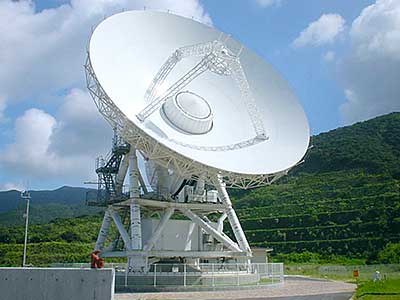
⭐ VERA Ishigakijima Station (VERA石垣島観測局)
Local interest in stargazing was really boosted in May 2002 with the completion of the VERA Ishigakijima Station on Ishigaki.
VERA Ishigakijima Station is a large 20-meter radio telescope, like a dish antenna pointed at the sky on a swiveling base. It’s basically a large, radio wave receiver detecting radio waves from planets, stars, and galaxies. Since the radio waves are so faint, the antenna dishes need to be very large to detect them.
Compared to optical telescopes for visual observations, the main advantage of radio telescopes is that the radio wave data can reveal things (such as black holes) that cannot be seen with optical telescopes. The radio wave data can be used to create radio images that reveal more detail than visual images. They can also detect the position and movement of heavenly bodies.
VERA is an abbreviation for “VLBI Exploration of Radio Astrometry,” and VLBI is “Very Long Baseline Interferometry” in reference to networked radio telescopes.
VERA Ishigakijima Station is one of four VERA radio telescopes in Japan linked together to work as one giant radio telescope. The other three VERA radio telescopes are in Oshu, Iwate Prefecture; Satsumasendai, Kagoshima Prefecture; and Ogasawara (Chichijima Island), Tokyo.
VERA Ishigakijima Station was the last of the four VERA radio telescopes to be built. It greatly expanded the VERA array’s diameter from 1,300 km to 2,300 km (spanning between Iwate Prefecture and Ishigaki). Their combined resolution is so high that they can even see a small coin on the moon. They collect radio wave data to track the position and movement of heavenly bodies in the Milky Way and to create a 3D map of the Milky Way. (I wonder how long that will take.) VERA telescopes seek to uncover the true Milky Way, and VERA also means “truth” in Latin.
Ishigaki’s excellent stargazing conditions attracted the National Astronomical Observatory of Japan (国立天文台) to build VERA Ishigakijima Station. Radio telescopes need to be in remote locations to avoid electromagnetic interference (EMI) from radio, television, and other electronic equipment. Being Japan’s most remote islands, Yaeyama is indeed an ideal place for radio telescopes.
VERA Ishigakijima Station is not far from central Ishigaki on a hill in the middle of nowhere (map here). You can drive there and see the antenna dish (beware of venomous habu snakes). It’s controlled remotely from the VERA control center in Iwate Prefecture.
One dark cloud looming over the VERA telescopes is budget cuts by the Japanese government. This has prompted high school students in Ishigaki and in Oshu, Iwate Prefecture (VERA control center) to start a petition for the continued, long-term operation of the VERA telescopes. So far, they have gathered several thousand signatures.
The Ishigaki students even met with Hagiuda Koichi, the Minister of Education, Culture, Sports, Science and Technology, when he visited VERA Ishigakijima Station in Sept. 2020. Let’s hope the VERA telescopes can continue to operate. They have been so inspiring to the younger generation.

Photo by National Astronomical Observatory of Japan.
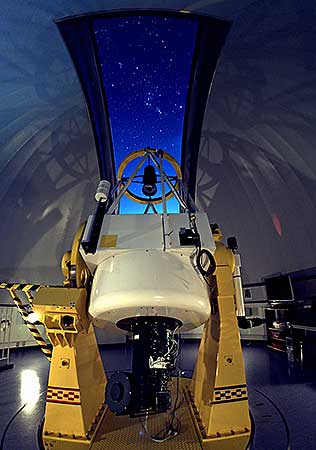
⭐ Ishigakijima Astronomical Observatory (石垣島天文台)
VERA Ishigakijima Station sparked so much local interest in stargazing that the Ishigakijima Astronomical Observatory was built in April 2006 by popular demand. It’s on Mt. Maesedake (前勢岳) near Banna Park in central Ishigaki (map here). With a 105cm diameter, its optical telescope is the largest in the Okinawa-Kyushu Region and nicknamed “Murikabushi,” a Yaeyama word for the Pleiades star cluster (Subaru in Japanese).
The Observatory is geared to educate students and the public about the solar system and planetary science. A few local high school students have even discovered new stars.
The Observatory is operated by multiple parties including the National Astronomical Observatory of Japan, the city of Ishigaki, University of the Ryukyus, and the Yaeyama Hoshi-no-Kai stargazing NPO.
The Yaeyama Hoshi-no-Kai (八重山星の会) NPO is a group of Yaeyama astronomy fans formed in Nov. 2000. They are very active and work as guides at the Observatory. They hold free stargazing sessions at the Observatory and Ishigaki City Hall. Check their Facebook page for the latest notices (in Japanese).
The public can tour Ishigakijima Astronomical Observatory for free or make reservations for stargazing shows (in the 4D2U Theater) and events.
*Ishigakijima Astronomical Observatory is currently closed due to a landslide on the access road. It hopes to reopen to the public in April 2021.
⭐ Southern Island Star Festival (南の島の星まつり)
VERA Ishigakijima Station also led to the founding of Ishigaki’s annual Southern Island Star Festival held during the Tanabata Star Festival in August. It’s a big outdoor evening picnic in a public park with people sitting on the grass, food stalls, stargazers with telescopes, and live music on stage by well-known local artists like Natsukawa Rimi. The climax is the “lights off” period when they turn off the park lights for people to gaze at the Milky Way.
The festival started in 2002 with 3,000 people (much more than expected) gathered in a local park for stargazing. The festival has since grown to around 9,000 attendees by 2019 when it was held at Painu-Hamacho Ryokuchi Park (南ぬ浜町緑地公園) near Ishigaki Port (see aerial photo below). It’s now Japan’s biggest stargazing festival.
There are also side events such as stargazing sessions at Ishigakijima Astronomical Observatory, open house at VERA Ishigakijima Station, a symposium, and planetarium shows. In 2020 due to coronavirus, the festival was held online with local artists like Begin and Natsukawa Rimi singing live. Hopefully, they will be able to hold it as usual in 2021.
⭐ Ishigakijima Hoshi-no-Umi Planetarium (いしがき島 星ノ海プラネタリウム)
If Ishigaki is too cloudy for weekend stargazing, go to Ishigaki Port’s boat terminal to visit Ishigakijima Hoshi-no-Umi Planetarium which opened in July 2019. The nine-meter dome screen shows Ishigaki’s coral reefs and starry skies. Wear 3D glasses to see the images in high-resolution 3D. Learn to recognize different stars, clusters, and constellations above Yaeyama. When you enter the boat terminal from the street, the planetarium is on the right side of the building. Open only on weekends from 10:30 am to 6:00 pm. Admission charged, non-reserved seating. Official map here or Google Map here.
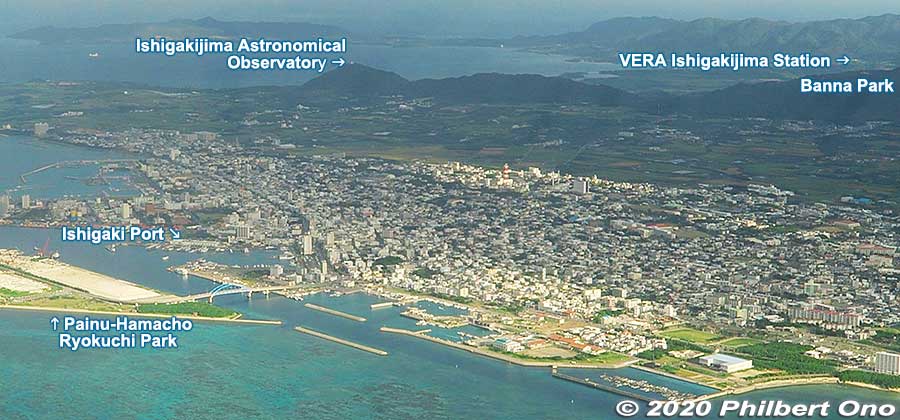
💫 Happy Stargazing 💫
Hope this article has shed some light on Yaeyama stargazing, still an obscure topic in English. When people can start traveling again, hopefully this article will see more light of day (or night). Will be updating/correcting this article in the months ahead. Thanks for reading. Japanese language learners can skim through the basic stargazing vocabulary list below. Also check out my other Yaeyama articles:
🌺 Other articles in this Yaeyama folklore series (so far):
Yaeyama Min’yo Overview | “Asadoya Yunta” | Yaeyama Stargazing | “Tinsagu nu Hana” | “Tsuki nu Kaisha” | “Tubara-ma” | Nosoko Maape | Kabira | Sakieda | Yaeyama Photos
Japanese Stargazing Vocabulary (Version 1.05)
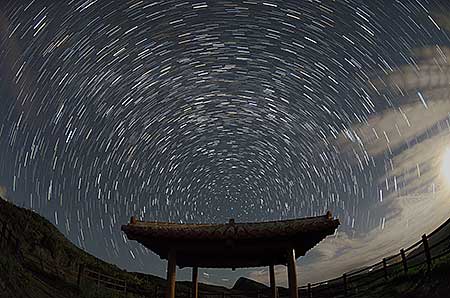
- uchū 宇宙 – outer space
- hoshi 星 – star or stars (in the sky)
- hoshi-zora 星空 – starry skies, stargazing
- hoshi-zora kansatsu 星空観察 – stargazing
- tentai 天体 – heavenly bodies
- seiza 星座 – constellation
- Subaru すばる – Pleiades star cluster. In Okinawan, called by different names like Murikabushi (むらかぶし) and Muribushi (群星). Pronounced “Su-BAH-roo,” not “Su-boo-roo” as they say it in the US.
- seidan 星団 – star cluster
- Hokkyokusei 北極星 – North Star
- Minami juji-sei 南十字星 – Southern Cross, Ishigaki’s official constellation.
- Orion-za オリオン座 – Orion (constellation). Names of constellations usually have the “za” suffix.
- Hakucho-za はくちょう座 – Cygnus (swan constellation)
- Hokuto shichi-sei or Oguma-za 北斗七星・おおぐま座 – Big Dipper (Ursa Major or Plough)
- Koguma-za こぐま座 – Little Dipper (Ursa Minor)
- Akutorusu アークトゥルス – Arcturus (Hōkūle‘a in Hawaii.)
- nagare-boshi 流れ星 or ryūsei 流星 – falling star, shooting star
- Tingara てぃんがーら – Milky Way in Okinawan. “Tin” means “heavens” equivalent to “Ten” (天) in Japanese. And “gara” is “gawa” (川) or river in Japanese. So “Tingara” is Okinawan for “River in the Heavens.” Almost the same as “Amanogawa” (天の川) in Japanese.
- Amanogawa 天の川 – Milky Way in Japanese.
- ginga 銀河 – galaxy
- seiun – 星雲 (literally “star cloud”) – nebula
- kōsei 恒星 – fixed star
- ittō-sei 一等星 – First-magnitude stars (the brightest stars in the night sky).
- Tanabata 七夕 – Star Festival on July 7 or Aug. 7
- nishi 北 – North in Okinawan. (Kita in Japanese.)
- hai 南 – South in Okinawan. (Minami in Japanese.)
- agari 東 – East in Okinawan. (Higashi in Japanese.)
- iri 西 – West in Okinawan. (Nishi in Japanese.)
- taiyō 太陽 – sun
- hinode 日の出 – sunrise
- hino-iri 日の入 – sunset
- chikyū 地球 – Earth (planet)
- tsuki 月 – moon
- tsuki-no-de 月の出 – moon rise
- tsuki-no-iri 月の入 – moon set
- tsukimi 月見 – moon viewing
- mangetsu 満月 – full moon
- ufutsuki 大月 – full moon in Okinawan
- tsuki no usagi 月の兎 – moon rabbit https://en.wikipedia.org/wiki/Moon_rabbit
- mikazuki 三日月 – crescent moon
- taiyō-kei 太陽系 – solar system
- wakusei 惑星 – planet
- Dosei 土星 – Saturn
- Kasei 火星 – Mars
- eisei 衛生 – satellite
- tenmongaku 天文学 – astronomy
- tenmondai 天文台 – astronomical observatory (telescope)
- planetarium プラネタリウム
- kōgai 光害 – light pollution
- gaitō 街灯 – street lights
- Kokusai Dark Sky Kyōkai 国際ダークスカイ協会 – International Dark-Sky Association has a Tokyo Chapter.
- Hoshi-zora Hogo-ku 星空保護区「ダークスカイ・パーク」- International Dark Sky Park
- sōgankyō 双眼鏡 – binoculars
- bōenkyō 望遠鏡 – telescope
- laser pointer レーザーポインター
- hoshi-suna or hoshi-zuna 星砂 – star-shaped sand grains created by tiny shell creatures.
References
https://murikabushi.jp/
https://www.nao.ac.jp/en/gallery/weekly/2016/20160802-ishigakijima.html
https://taru.ti-da.net/e570937.html
https://ja.wikipedia.org/wiki/%E3%81%A6%E3%81%83%E3%82%93%E3%81%95%E3%81%90%E3%81%AC%E8%8A%B1
https://taru.ti-da.net/e2696559.html
https://ja.wikipedia.org/wiki/%E6%9C%88%E3%81%AC%E7%BE%8E%E3%81%97%E3%82%83
「沖縄の美ら星―四季の星空ガイド」 – 宮地竹史 (著) (ISBN-13: 978-4908598418)
http://ir.lib.u-ryukyu.ac.jp/handle/20.500.12000/550
https://star-festival.amebaownd.com/pages/502590/page_201606082032
https://yaimatime.com/schedule/event/84580/
https://www.churashima.net/shimauta/30/02.html
https://www.nippon.com/en/japan-topics/g00862/
https://www.haimurubushi.co.jp/activity/sky/index.html

